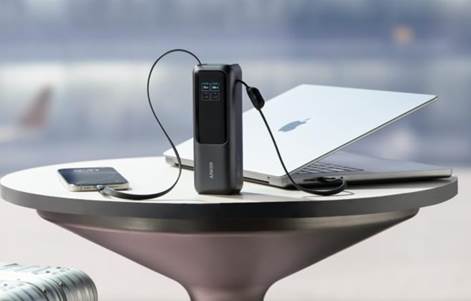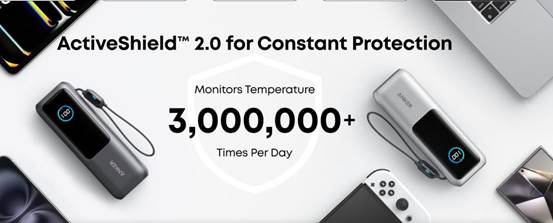Choosing
the correct power bank might be intimidating owing to the sheer quantity of
functions and technical language involved. Consumers desire a gadget that fits
their lifestyle, whether for daily use, travel, or emergency. From charging
speed to safety certifications, the criteria extend beyond battery size.
Today's shoppers are also looking for compatibility with laptops and smart
devices, particularly models like the Anker Power Bank (25K, 165W), which
stands out for its built-in connectors and quick charging. Knowing what is
truly important might help purchasers make better judgments and avoid the
frustration of acquiring a subpar product.

What Do Most Buyers Look for in a Power Bank?
Battery Capacity and Device Compatibility
Battery
capacity is one of the first things that purchasers look at. More charges are
possible with a greater mAh rating, but compatibility is also very important.
For instance, the 25,000mAh Anker Charge Bank is ideal for both work and travel
since it can charge tablets, cell phones, and laptops. Additionally, consumers
use algorithms that account for energy loss to determine charge counts. A
normal smartphone with this model receives four to five full charges. It is a
good all-arounder due to its universal compatibility with gadgets like the
MacBook Pro and iPhone 16. In a nutshell, consumers prefer power banks with a
large capacity and flexible charging options.
Fast Charging and Input/Output Ports
Fast
charging is now expected rather than a luxury. Customers actively compare
ports, input/output wattage, and the ability to charge numerous devices at
once. With three 100W USB-C connections and a maximum output of 165W, power
banks such as Anker's 165W model guarantee quick and simultaneous charging of
gadgets like laptops and phones. Additionally, built-in wires facilitate
seamless on-the-go use. Customers value speedy recharging as well; in just 20
minutes, this device achieves 30%. Power banks that put speed and efficiency
first are the obvious winners in the fast-paced world of today.
Size, Weight, and Portability
Portability
is still quite important, especially for those who use their power bank
frequently or for extended travel. The portability of the item is directly
impacted by its weight and size. Because it is lightweight and compact enough
to take in a backpack or carry-on, the Anker 25K model is a favorite among both
adventurers and professionals. Retractable cords improve portability and
clutter reduction, and an integrated strap doubles as a carrying handle.
Lightweight yet strong versions are more likely to be preferred by users who
want great performance without the bulk.
Are Safety Features and Certifications Deal-Breakers?
Overcharge, Overheat, and Short-Circuit Protection
Today's
tech-savvy consumers demand absolute safety. Overcharging, overheating, and
short circuit protection are now expected as standard features. Advanced models
such as the Anker 25K include ActiveShield 2.0, which monitors temperature over
3,000,000 times each day to avoid harm. These features provide secure and
worry-free charging for all connected devices. Whether charging high-demand
products like laptops or delicate accessories like earbuds, users rely on power
banks that emphasize their equipment's safety. A trustworthy power bank does
more than just charge; it also protects.
Certification Labels: CE, FCC, RoHS Explained
Consumers
are increasingly recognizing the importance of certification markings in the
selection of power banks. The FCC certifies that electronic emissions in the US
comply with regulations, CE guarantees adherence to European safety standards,
and RoHS confirms the limitation of dangerous substances. Customers can be
certain that the product complies with international safety and environmental
requirements due to these certifications. Although some consumers may overlook
these nuances, discerning consumers identify them as indicators of production
quality and product reliability. The Anker 25K reinforces its reputation as a
reliable and efficient charging solution with these certifications.
Certifications transcend mere labels; they signify a product's validity.
Built Quality: Fireproof Casing and Heat Dissipation
Durability
and material quality frequently affect a power bank's longevity. Users like a
durable design that can survive travel and daily wear. Power banks with
fire-resistant casing and effective heat dissipation are more popular. The
Anker 25K model is built with high-quality materials that withstand heat and
physical stress. This not only increases the device's life but also shields
users and their devices from potential risks. A robust power bank makes all the
difference when thrown into a backpack or used in extreme temperatures.

What Are the Latest Trends in Power Bank Features?
Wireless Charging and Pass-Through Tech
Modern
purchasers choose wireless charging and pass-through technology. These
capabilities provide more versatility, allowing users to charge a power bank
while also powering another device. Anker's power bank offers pass-through
charging, making it ideal for professionals on the road. Although this model
does not enable wireless charging, its excellent pass-through capabilities and
smart power allocation meet current standards. Buyers are increasingly
prioritizing features that improve workflows and minimize downtime. Power banks
that provide more than basic charging are increasingly becoming the norm.
Solar Charging and Eco-Friendly Materials
Sustainability
is growing in popularity among power bank users. Many people are increasingly
looking for solar-powered solutions or things manufactured from recycled and
environmentally friendly materials. While the Anker 25K does not use solar
power, it does exceed environmental regulations thanks to RoHS certification,
which indicates that it contains few dangerous substances. This makes it a
safer choice for both people and the environment. As consumer knowledge
develops, so does the demand for environmentally friendly energy alternatives.
Although solar charging is still a new technology in this field, eco
certifications can help guide prudent decisions.
Built-in Cables, Displays, and Smart Features
The
power bank industry is all about convenience. Customers like elements that
enhance the user experience, such as integrated wires, real-time displays, and
clever functions. One of the two retractable USB-C cables on the Anker 25K may
be used as a carrying strap, eliminating the need for further accessories. Its
smart display allows users to quickly view the battery percentage, port status,
and anticipated recharge durations. These features keep consumers informed and
facilitate navigation. High-performance models can be distinguished from their
less costly counterparts by these characteristics. For everyone who appreciates
efficiency and readiness, a smart, self-contained power bank is appealing.
Conclusion
When
shopping for a power bank, most consumers weigh capacity,
compatibility, speed, and safety. Current premier versions, such as the Anker
25K, incorporate integrated safety mechanisms, rapid charging capabilities, and
multi-device compatibility inside a small, travel-friendly configuration.
Certifications promote environmental stewardship and quality assurance. Users'
demands for smart screens, retractable cables, and enhanced security measures
are increasing in tandem with technological advancements. Informed buyers
invest in products that fulfill changing requirements while remaining reliable
and innovative rather than opting for any charger. By comprehending these
essential comparative elements, you may confidently select a power bank that
will ensure you remain charged wherever life leads you.
